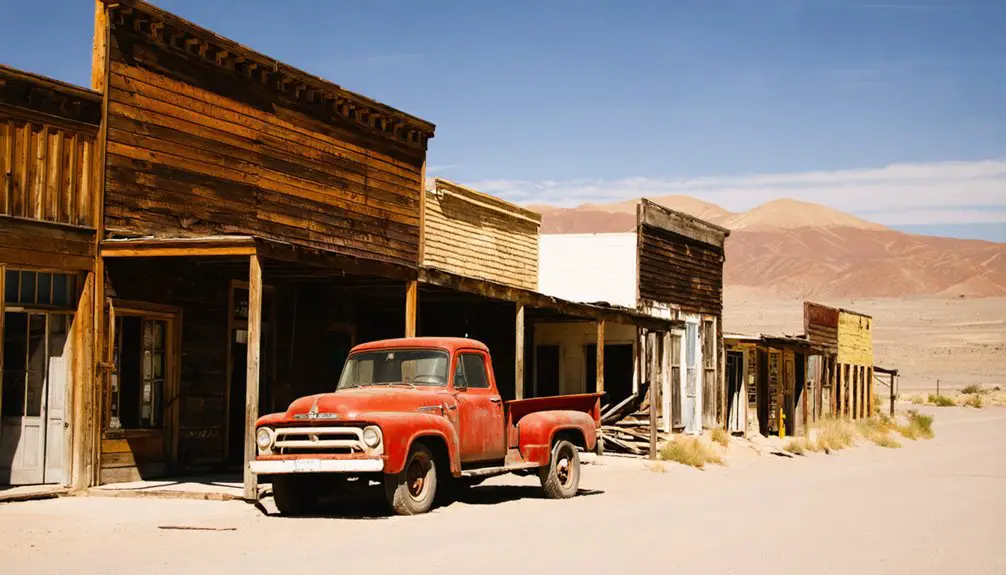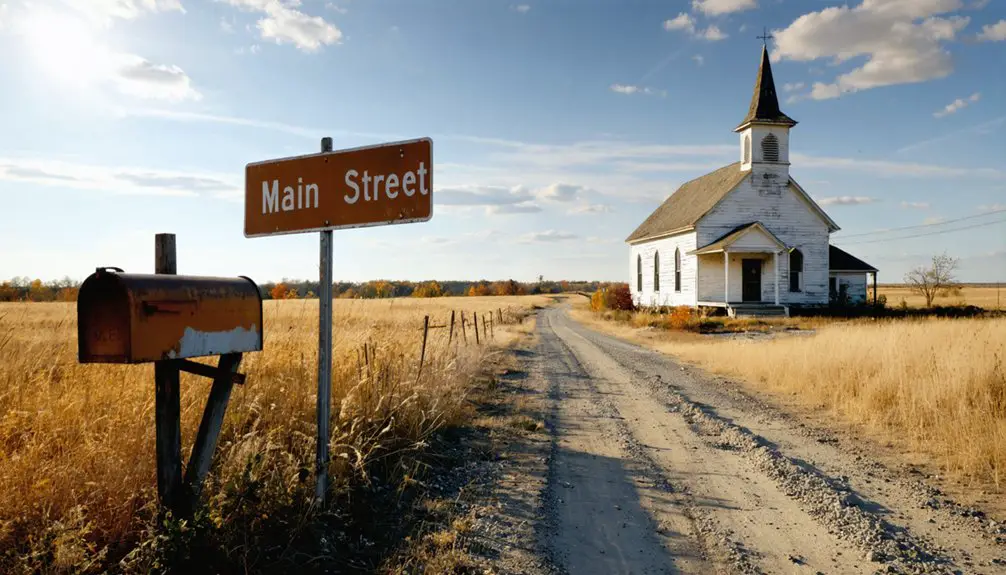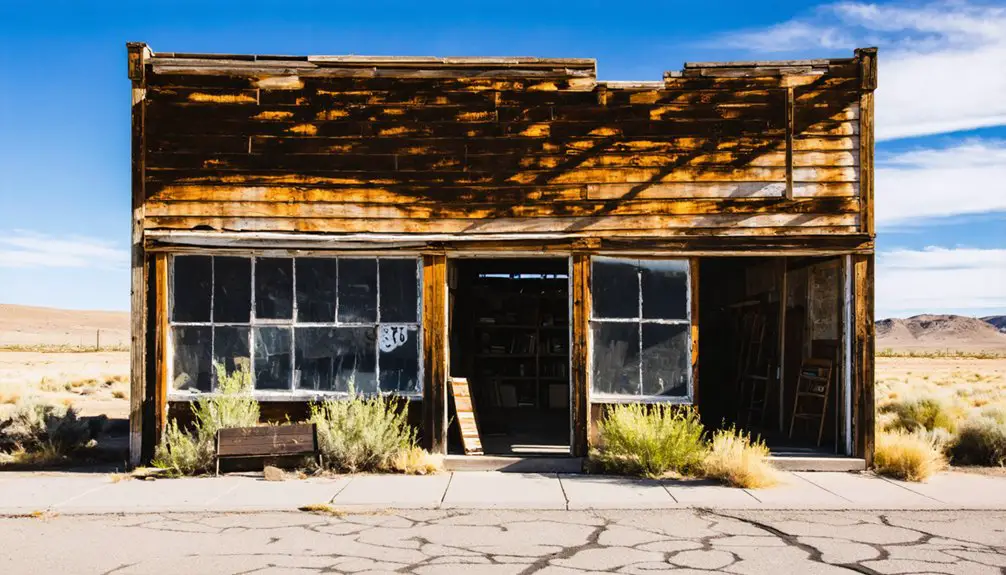You’ll find Antelope, Oregon nestled in the high desert, where it began as a stage station in 1863 along The Dalles-Canyon City Road. The town flourished as a wool trade and mining hub until an 1898 fire devastated nearly every building. Though rebuilt, it later gained notoriety during the 1980s Rajneesh movement‘s controversial occupation. Today, with fewer than 50 residents, this near-ghost town’s layered history spans frontier prosperity to spiritual commune to quiet outpost.
Key Takeaways
- Founded in 1863 as a stage station, Antelope thrived as a vital waypoint for wool trade and mining until 1898.
- The Great Fire of 1898 destroyed nearly every building, causing many residents to abandon the town permanently.
- Population declined due to job losses, inadequate infrastructure, and devastating forest fires that crippled the local economy.
- The Rajneesh movement temporarily revitalized Antelope in the 1980s before their controversial activities led to their departure.
- Today, Antelope remains sparsely populated but maintains its historical identity through preservation efforts and community initiatives.
From Settlement to Frontier Hub (1862-1898)
While the American West was still being settled, the Wheeler family established the first permanent settlement in Oregon’s Antelope Valley in 1862. The following year, Howard Maupin founded Antelope as a stage station along The Dalles-Canyon City Road, setting early settlement patterns in motion.
You’ll find that Antelope’s evolution from a small agricultural outpost to a bustling frontier hub reflected significant economic shifts. By the 1870s, the town had become a crucial waypoint between the Columbia River and mining regions, supporting both the regional wool trade and mining operations. A post office was established to serve the growing community as more settlers arrived.
Multiple saloons, smithies, and establishments catering to miners and travelers sprouted up, creating a lively social scene. The town’s strategic location fostered its growth until 1898, when a devastating fire destroyed most of its original structures, though rebuilding efforts quickly followed, including the construction of the A.O.U.W. lodge which became a center for social gatherings.
The Great Fire and Rebuilding Years
Antelope’s development came to an abrupt halt when a fire erupted above the town’s bowling alley in 1898, consuming nearly every building in town except one.
You’ll find that the determined residents quickly began rebuilding their homes and businesses, demonstrating remarkable resilience in the face of complete devastation.
While the town was reconstructed with improved materials and safety measures in mind, Antelope’s population and economic vibrancy would never return to its pre-fire levels. Though the town struggled over the decades, the appointment of Fire Chief Carter in 2011 brought renewed focus on emergency preparedness and safety. The 2021 wildfire season proved particularly challenging when extreme fire behavior threatened nearby communities in California’s Klamath National Forest.
Fire’s Total Devastation
Devastation struck the frontier town of Antelope in 1898 when a fire erupted in an apartment above the local bowling alley, rapidly consuming nearly every structure in its path.
You’d have witnessed the fire’s merciless progression through the wooden buildings, leaving only one structure standing by nightfall. The town’s vulnerability to fire hazards was typical of frontier settlements, where limited firefighting capabilities meant flames could spread unchecked.
In the aftermath, you’d have seen the community face significant rebuilding challenges. The destruction of essential businesses, including stores and blacksmith shops, crippled the town’s economic foundation.
This catastrophic event triggered a period of temporary abandonment, with many residents choosing to leave rather than rebuild, ultimately contributing to Antelope’s decline.
Town Rebuilds From Ashes
From the smoldering ruins of the 1898 fire emerged a determined effort to resurrect Antelope through strategic rebuilding initiatives. The town’s rebuilding strategies emphasized fire-resistant materials, with brick and stone replacing vulnerable wooden structures. Architectural influences drew from Victorian-era styles, particularly Italianate and Second Empire designs common in post-fire Oregon towns. Like Portland’s recovery after 1866, the city received donated relief supplies from neighboring communities. Drawing lessons from the devastating Big Blowup of 1910, the town prioritized fire prevention measures.
- Commercial buildings received priority fireproofing to quickly restore trade.
- New infrastructure included wider streets and improved firefighting capabilities.
- Essential services like the post office and schools were rebuilt to maintain community functions.
While you’ll find the reconstruction attracted skilled workers and temporarily boosted the local economy, Antelope’s revival proved short-lived. Competition from nearby Shaniko and declining mining activities ultimately prevented the town from regaining its former prominence, despite the ambitious rebuilding efforts.
Population Never Fully Recovered
Despite ambitious rebuilding efforts following the Great Fire of 1910, the rural town’s population entered a steep decline that would prove irreversible.
You’ll find that multiple factors contributed to this sustained population decline, including the loss of ranch and logging jobs, limited emergency services, and inadequate infrastructure investment.
The town’s isolation and lack of railroad connections severely hindered its ability to attract new residents and businesses. The devastating fires destroyed an estimated half billion board-feet of valuable timber in the region, further crippling the local economy.
While the community’s resilience showed through various reconstruction attempts, the combined impact of recurring forest fires, harsh weather conditions, and the controversial religious group occupation in the 1980s perpetuated the exodus.
Today, with only about 47 residents, Antelope stands as a reflection of how natural disasters and sociopolitical disruptions can permanently alter a town’s demographic trajectory.
Life in Early Antelope: Commerce and Culture
When gold was discovered at Canyon Creek in 1862, Antelope quickly transformed from a simple wagon road station into a bustling commercial hub. Nearly 10,000 miners passed through within a year, establishing the town’s early freight economy.
You’d find pioneer heritage deeply woven into the community, from Nathan Wallace’s general store to Howard Maupin’s post office established in 1871. The area’s rich history includes Native American settlements that predated the town’s founding. The region’s wildlife included several antelope species that roamed the savannahs before their eventual disappearance.
- A thriving wool trade centered around the Columbia Southern Railway’s arrival in 1900
- Daily stagecoach service connected Shaniko’s railway terminal to Antelope
- The Ancient Order of United Workmen provided social support for dangerous occupations
The town’s commerce flourished through multiple sectors, including ranching, sheep raising, and retail businesses serving steady freight traffic.
Social organizations and literary figures like H.L. Davis contributed to a rich cultural fabric that defined early Antelope life.
The Rise of the Rajneesh Movement

You’ll find the Rajneeshees quickly established control over Antelope through strategic population movements and voter registration that allowed them to dominate local governance.
Their expanding influence led them to officially change the town’s name from Antelope to Rajneesh in 1984, heightening already strained relations with longtime residents.
The Rajneeshees built their own police force and other essential services to maintain control over the community.
The movement’s aggressive tactics and intimidation of county officials created an atmosphere of fear and mistrust, setting the stage for escalating conflicts with authorities.
Power Through Population Control
Through strategic population management and voter manipulation, the Rajneesh movement established significant control over Oregon’s Wasco County between 1981 and 1988. Their population tactics transformed an empty ranch into a self-contained city of up to 7,000 residents, complete with modern infrastructure and its own ZIP code.
- They incorporated Rajneeshpuram as a city, using Oregon’s municipal laws to gain administrative autonomy.
- By moving followers en masse to Antelope, they secured political control and renamed the town to Rajneesh.
- Their voter manipulation included mass voter registration and attempts to influence local elections through extreme measures.
The movement’s calculated approach to population control extended beyond mere numbers – it was an all-encompassing strategy to merge religious authority with municipal power, effectively reshaping the region’s political landscape while resisting county oversight.
Criminal Activity Escalates Tensions
As criminal activities within the Rajneesh movement intensified between 1984-1985, the commune’s leadership orchestrated a series of increasingly dangerous plots that included assassination attempts, bioterrorism, and widespread surveillance operations.
You’ll find that these criminal conspiracies weren’t isolated incidents but part of a calculated strategy.
The commune launched America’s largest bioterror attack by contaminating local salad bars with Salmonella, sickening over 750 people. They plotted to assassinate U.S. Attorney Charles Turner to derail immigration fraud investigations.
Behind the scenes, they operated one of the nation’s most extensive wiretapping networks to monitor threats and critics. Communal violence and intimidation became tools for maintaining control, while leaders engaged in immigration fraud through sham marriages.
These activities ultimately led to federal investigations and multiple criminal indictments.
A Town Transformed: The Rajneesh Years
The sleepy town of Antelope experienced a dramatic transformation in 1981 when followers of the Rajneesh movement purchased over 60,000 acres of nearby land to establish their commune, Rajneeshpuram.
The Rajneesh community impact was immediate and far-reaching. Through strategic voter registration and political maneuvering, they gained control of Antelope’s city council by 1982.
Urban infrastructure development exploded as the commune grew to house thousands, complete with:
- A self-contained city featuring malls, restaurants, and its own police force
- An airstrip and public transportation system
- A bustling post office and emergency services
After the Commune: Return to Antelope

Following the commune’s dramatic collapse in September 1985, Antelope’s original residents reclaimed their town with determination and purpose. In a unanimous 34-0 vote, they restored the town’s original name from Rajneeshpuram, marking a significant step toward cultural reclamation. The old school transformed into a community center, reinforcing their communal identity.
In a powerful display of unity, Antelope’s residents voted 34-0 to erase Rajneeshpuram and restore their town’s original identity.
While the Big Muddy Ranch changed hands several times, selling for just $4.5 million at auction in 1988, Antelope itself returned to its quiet roots.
The property eventually found new purpose under Young Life’s ownership in 1996, becoming a youth summer camp.
Today, you’ll find few physical traces of the commune era beyond an old garage, as the town successfully shed the controversial chapter of its history and reclaimed its small-town character.
Preserving a Unique American Ghost Town
Modern preservation efforts in Antelope reveal a ghost town that’s uniquely alive, balancing its historical legacy with contemporary purpose.
Through dedicated community involvement, you’ll find historic preservation projects breathing new life into 19th-century structures, including the transformation of an old school into a community center and the maintenance of one of the last remaining A.O.U.W. lodges as a museum.
- The town’s 2024 Dark Sky Community certification creates a new identity focused on astro-tourism
- Local residents Barbara Beasley and Cody Flecker actively preserve both early settlement and Rajneesh-era histories
- Adaptive reuse of the former commune as Washington Family Ranch guarantees economic sustainability
These preservation efforts showcase how a small community can maintain its architectural heritage while adapting to contemporary needs, proving that ghost towns don’t have to fade into obscurity.
Frequently Asked Questions
Is Antelope, Oregon Open to Public Visits and Exploration?
You can freely visit and explore the town, as there’s public access without specific visitor guidelines. While small and rural, it welcomes tourists interested in its dark skies and historical sites.
What Paranormal Activity Has Been Reported in Antelope’s Abandoned Buildings?
You’ll encounter reports of ghost sightings, shadowy figures in windows, eerie sounds like footsteps and whispers, unexplained door slams, and EVP recordings throughout the abandoned buildings, particularly in the old schoolhouse.
Are There Any Original Artifacts From the 1800S on Display?
Peering into preserved places, you’ll find few formal displays of frontier-era artifacts. The A.O.U.W. Hall houses mainly 1980s Rajneeshpuram items, while historic buildings stand as silent structural witnesses to bygone days.
Can Visitors Stay Overnight in Any of Antelope’s Historic Structures?
You can’t stay overnight in Antelope’s historic structures. While there are camping and RV options available at the designated campground, historic accommodations aren’t permitted for overnight experiences due to preservation and safety regulations.
What Is the Best Time of Year to Photograph Antelope?
With 70% clearer skies, spring (March-May) offers you ideal seasonal photography conditions. You’ll get mild temperatures, blooming wildflowers, and potential wildlife encounters, plus fewer tourists to disrupt your perfect ghost town shots.
References
- http://noospheregeologic.com/blog/2016/03/02/antelope-oregon-the-town-we-like-to-call-rajneesh-because-were-insane/
- https://architecturalafterlife.com/2022/06/antelope-oregon/
- https://www.youtube.com/watch?v=GX_z7FC8_HI
- https://traveloregon.com/things-to-do/culture-history/ghost-towns/antelope-2/
- https://en.wikipedia.org/wiki/Antelope
- https://www.spokesman.com/stories/2018/jul/22/museum-tells-of-two-pasts/
- https://www.oregonencyclopedia.org/articles/city_of_antelope_muddy_ranch/
- https://disquefoundation.org/2014/10/meet-michael-carter-fire-chief-of-antelope-or/
- https://en.wikipedia.org/wiki/Antelope_Fire
- https://npshistory.com/publications/crla/ne-fire-history.pdf



